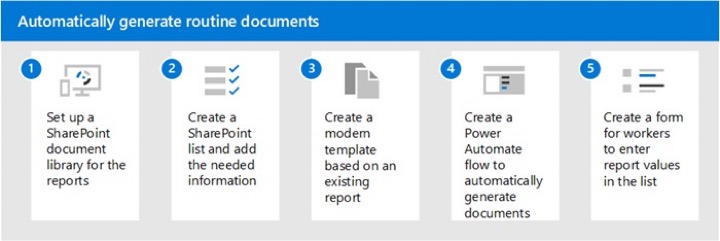
Create Word Documents with Microsoft Syntex & Power Automate
Automate document creation with Microsoft Syntex and Power Automate for efficient business operations.
Understanding Microsoft Syntex and Power Automate
The core of this blog focuses on using Microsoft Syntex in combination with Power Automate for generating documents in SharePoint from list items. It delves into how to create a template using Microsoft Syntex Content Assembly and Power Automate to create business files on the go, using a case study of creating an offer letter for a contractor.
This process notably utilizes the capabilities of Content Assembly in Microsoft Syntex to auto-generate repetitive business documents, reducing the time and effort needed from manual input.
The setup in this example is such that a business user can input all relevant information in a manually activated Power Automate flow, which then generates the document using the template made with Microsoft Syntex. To apply more context to Microsoft Syntex, you can click here.
The blog further breaks down the procedure into steps, starting from creating a word document with a sample offer letter with text placeholders, which can later be chosen for replacement with fields while building the template.

Steps are inclusive but not limited to: navigating to the document library, selecting an option to create a modern template, uploading a file, starting configuration of fields on the model, choosing the data from the document for replacement, and adding the field.
The procedure also outlines how to use Power Automate. It starts with a manual flow trigger: The flow will be manually activated, so a manual trigger is used to start the flow. It proceeds to establish the action "Generate Document using Microsoft Syntex (Preview)," where you get to select the Site, Document Library, and the template.
All in all, the blog presents a comprehensive tutorial on how to use Microsoft Syntex and Power Automate for creating customized documents based on templates. This process minimizes the need for manual data entry, making it an efficient approach for businesses dealing with repetitive documents.
With proper execution, Power Automate and Microsoft Syntex allow you to auto-generate documents like offer letters, with the possibility for the whole process to be even further simplified by using Power Apps and other data sources to pre-populate existing data.
Learn about Use Microsoft Syntex generate documents in SharePoint using Power Automate
In this guide, we shall discuss the process for generating documents from list items with Microsoft Syntex and Power Automate. Our journey will first touch on setting up Microsoft Syntex billing. From there, we shall delve into creating templates with Microsoft Syntex Content Assembly and using said templates with Power Automate.
To get started with Syntex, your account must be configured for Azure Pay As You Go. This is a critical first step before we delve into document creation with Power Automate.
One of the exciting features we shall explore is using Content Assembly in Microsoft Syntex. This function allows the automatic generation of repetitive business documents. Indispensable, isn't it? Worth noting, though, is that you will need to have setup Microsoft Syntex before you can leverage these features.

Our example will involve designing a setup that generates an offer letter for a contractor. Business users will be able to provide all relevant data, which will feed into a manually triggered Power Automate flow. The result? A document crafted using a pre-designed template from Microsoft Syntex!
In the following steps, we will navigate to the document library and generate a modern template. This will involve browsing files located either in the SharePoint Document libraries or from your device. Once the template is uploaded, we will make a start on configuring fields.
As we proceed, we will be choosing data from the document for replacement and adding fields. You can decide whether to replace the selected data or simply add it as a form field. Once this step is complete, the next involves configuring the data definition. Here, we will directly select the data type for the field.
Our next phase will cover using Power Automate. The automation tool will be manually triggered to generate the offer letter. The trigger configuration will enable a series of inputs to be populated as needed. From contractor name and email to address, role, contract dates, hourly rate, supervisor details, place of work, and recipients of the offer letter, the input is extensive.
Through Microsoft Syntex, we are able to automate the generation of documents. From a Word document, convert it into a PDF through OneDrive, integrate approvals and automate the process of document status. A truly streamlined and efficient process!
To encapsulate, this guideline walks you through creating a template with Microsoft Syntex Content Assembly. It guides you on generating documents automatically with Power Automate. By tapping into Power Apps, data sources can pre-populate existing data. This simplifies the process, rendering it even more efficient. Stay tuned for more exciting features!
Keywords
Microsoft Syntex, generate documents, SharePoint, Power Automate, SharePoint automation, document generation, Microsoft workflow, content understanding, SharePoint documents, Microsoft AI